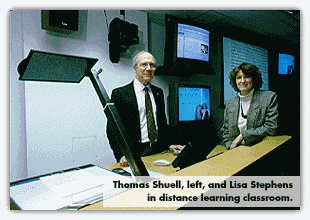

Located in 200G Baldy Hall on UB's North Campus, it is a completely interactive, full-motion video learning and conferencing center.
The $160,000 facility was funded and developed principally by a consortium made up of the School of Engineering and Applied Sciences, Office of the Provost and Graduate School of Education. It is available for use by any UB academic department.
The first course to be offered live via the new facility is a graduate course on public-school finance taught by Austin Swanson, professor and chair in the Department of Educational Administration, Organization and Policy in the Graduate School of Education. Graduate students will participate in the class via distance-learning labs at Pioneer High School in Arcade and Franklin Elementary School in Olean.
The special classroom, linked to a satellite site in Bell Hall, was designed and implemented by Engineering Computer Services under the supervision of Lisa Stephens, lead technician on the project.
It is designed to accommodate the needs of EngiNet, the state-wide learning network that connects SUNY engineering schools with one another and with industries throughout the state.
Engineering classes for up to 45 students are now produced in the Baldy lab and distributed under the auspices of EngiNet to the SUNY universities at Stony Brook and Binghamton and the SUNY College at New Paltz, all of which have engineering departments. UB receives tapes of classes taught at the other SUNY institutions.
Currently, four EngiNet courses are offered through the new lab, taught by Christina Bloebaum and Joseph Mook, assistant professor and associate professor, respectively, in the Department of Mechanical and Aerospace Engineering; Cemalettin Basaran, assistant professor of civil engineering, and John Zahorjan, adjunct professor of industrial engineering.
The lab links with the campus-wide cable system, so that information can be broadcast into different classrooms and dormitories," said Corky Brunskill, director of Engineering Computer Services.
Associate Provost Sean Sullivan said the lab is part of the provost's Educational Technology Action Plan, which focuses on the university's goals in the rapidly evolving field of educational technology.
"The lab is a prototypical site that employs several different kinds of distance-learning technologies and involves coordination among different faculties with different needs," Sullivan explained.
"It will let us get our feet wet by studying different distance-learning technologies, teaching approaches and the demand for various methods by various schools and faculties," he added.
The Baldy Hall learning facility resembles UB's first real-time distance learning site, the Roswell Park Distance Learning Lab located in the basement of Abbott Hall on the South Campus.
Both are "synchronous" learning labs. That is, students and instructor at all connected sites are visible and audible to one another, making real-time class instruction and discussion possible across the miles. On-screen digital data, slides, overhead projections and other visual materials also can be broadcast live.
The Abbott Hall site, which does not involve fiber optics, has been used to teach, among other things, UB's nurse practitioner graduate-degree program to students in the Southern Tier at a learning site in Olean. Many of the enrolled nurses are in their fifth semester of study.
David Ellis, associate professor of medicine and chair of UB's campus-wide distance learning committee, said an investigation is under way regarding use of that lab for the preceptorship phase of the nurse practitioner's program. Physician preceptors or mentors, using a portable broadcast system, will broadcast live to the students, allowing them to question patients and develop diagnostic experience.
Thomas Shuell, professor of education and director of the Center for Educational Resources and Technologies in the Graduate School of Education, explained that the Abbott Hall lab, which opened in 1995 and has been upgraded several times since, operates with ISDN (Integrated Services Digital Network) technology, a synchronous system that is relatively slow and relies on point-to-point connections.
Shuell and Ellis pointed out that ISDN-operated labs can connect to phone-in sites all over the world, but, as sites are added, Shuell said, visual quality can deteriorate, depending on the number of telephone lines dedicated to the system.
The Baldy Hall classroom has ISDN or digital connection capabilities as well. Over the fiber-optic network, however, broadcast communication is limited to sites on that particular network.
The fiber-optic network of which the Baldy site is a part, Shuell explained, is called "Project Connect." It was developed by Erie I BOCES (Board of Cooperative Educational Services), which serves a number of school districts in Erie County.
"Project Connect" links the Baldy Hall site with 24 learning labs located in several BOCES facilities, 11 Western New York school districts and Buffalo State College. Instruction in virtually any discipline at any grade level-elementary through graduate study-can originate at any of the learning sites and be transmitted simultaneously to up to three other sites on the system, making possible live interaction among instructor and students at those sites.
The BOCES system has been up and running for some time and UB faculty have taught courses through a lab in the Williamsville School District, making otherwise inaccessible classes available to rural, suburban and city school districts on the system.
Sullivan, Ellis and Shuell said distance-learning technology doesn't necessarily save money, at least up front. It is, instead, a method by which UB can make scholarship-Ellis calls it "our product"-more convenient and readily available to a broader audience through such technologies as synchronous live broadcast, and non-synchronous technologies like videotape and software applications that create a virtual-classroom environment on the Internet
Is "live" distance learning the wave of the future or a techy trend? Is it the Beta or the VHS of our educational future?
There's no way to know yet, said Sullivan, who says the goal should be to make different systems and different technologies available, teach people to use them and see which ones work best for whom.
